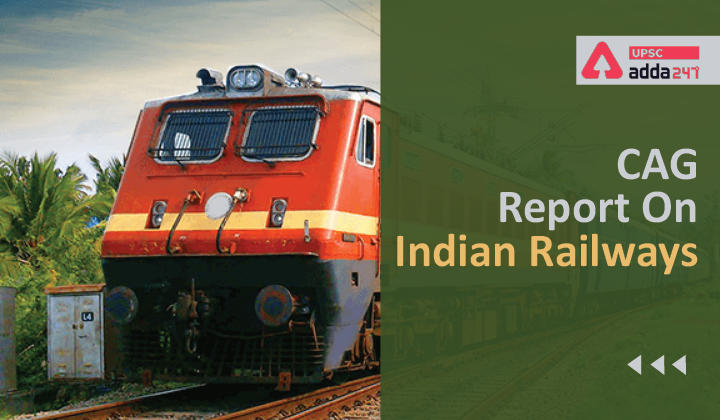Table of Contents
CAG Report on Indian Railways: Relevance
- GS 3: Infrastructure: Energy, Ports, Roads, Airports, Railways etc.
CAG Report on Indian Railways: Context
- The Comptroller and Auditor General (CAG)has recently tabled a report on Indian Railways in Parliament and noted that the financial health of Indian Railways is actually worse than the number shows.
CAG Report on Indian Railways: Key points
- CAG reported that the Indian Railways’ operating ratio was 98.36% in 2019-2020. However, if the actual expenditure on pension payments is taken into account, the ratio will be 35 %.
- Railways had earlier targeted to reduce its operating ratio to 95%.
- It means that the operating ratio of 98% does not reflect the true financial performance.
- CAG was of the view that Indian Railways needs to revisit the passenger and other coaching tariffs so as to recover the cost of operations and reduce losses in its core activities.
- In 2019, CAG reported that Indian Railways has the worst operating ratio in the past 10 years at 98.44% and its revenue surplus has decreased by more than 66%.
- Last year, the Indian Railways reduced its expenditure and the shortfall was managed through revenue generated by freight operations.
- Also, Indian Railways’ pension bill of more than Rs 51,000 crore in the current financial year has been converted into a loan by the finance ministry, which has also helped in managing its balance sheet.
What is Operating Ratio?
- In finance, the Operating ratio is a company’s operating expenses as a percentage of revenue.
- It is calculated by dividing the operating expenses by the net sales.
- Greater the Operating Ratio, the weaker is the organization’s ability to generate profit and vice versa.
Reasons of mounting losses of Railways
- The government in its Medium-Term Fiscal Statement 2019-20 said that the operating expenses and pension payments have soared in the recent past.
- Since the implementation of 6th and 7th Central Pay Commission, the working expenses have seen a substantial growth.
- Moreover, the earning growth has also not sustained.
- Due to COVID-19, Indian Railways has suffered a huge loss in passenger revenues due to pandemic induced restrictions.
Improving Indian Railways: Way forward
- Growing freight and passenger revenues: Dedicated freight corridors and running of private passenger trains could help in increasing revenue. Economic Survey has also National Rail Plan’s objective to increase the share of freight trains from present 27% to 45%.
- Demand-driven approach: Indian Railways should cater to high demand routes commodities. For example, in the passenger segment, there is a high demand for overnight travel, which should be met.
- Multi-modal approach: For freight customers, the promise of end-to-end connectivity via tie-ups with ports and inland waterways could help railways earn revenues better.
- Indian Railways should focus on corporatizing its structure, monetising and PPP so that revenue earned could be invested back in improving trains.
- Improving Operating Ratio: Four priority areas
- Expedite organisational reforms
- Second, enhance staff productivity and efficiency.
- Third, digitisation, automation and use of high-end technologies in Indian Railways
- Fourth, professional selection and management of projects to minimise costs and time overruns.
Also Read:





 TSPSC Group 1 Question Paper 2024, Downl...
TSPSC Group 1 Question Paper 2024, Downl...
 TSPSC Group 1 Answer key 2024 Out, Downl...
TSPSC Group 1 Answer key 2024 Out, Downl...
 UPSC Prelims 2024 Question Paper, Downlo...
UPSC Prelims 2024 Question Paper, Downlo...
